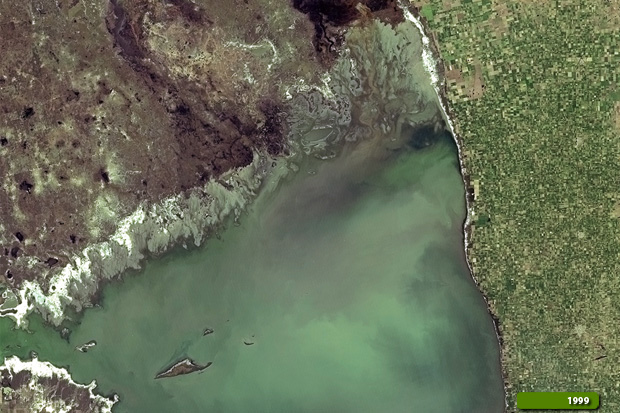|
Shrinking lake Mar Chiquita
Mar Chiquita or Mar de Ansenuza is an endorheic salt lake located in the northeast of the province of Córdoba, in central Argentina. The northeast corner of the lake also extends into southeastern Santiago del Estero Province. It is the largest of the naturally occurring saline lakes in Argentina. The lake is located in parts of five departments in the two provinces. The lake is in the Argentine Espinal ecoregion. It occupies the southern part of a depression that measures about 80 km (north–south) by 45 km (east–west). Its surface area varies considerably, given its shallow depth (about 10 m), and ranges between 2000 and 6000 km2. Mar Chiquita is fed primarily by the saline waters of the Dulce River, coming from Santiago del Estero in the north after being joined by the Saladillo River. The lands around the lower course of the Dulce and Mar Chiquita are wetlands, populated by a large biodiversity (especially aquatic birds). From the southwest the lake receives the flow of the Primero/Suquía and the Segundo/Xanaes rivers, as well as several streams; these inflows vary greatly from dry to rainy seasons. The salinity of Mar Chiquita is quite variable, with measured extremes ranging from 250 g/l in times of low water levels to around 40 g/l in very humid years, such as in the decade following 1977, when record rainfall flooded much of Miramar, Córdoba. There are several islands in the lake, the most important one being the Médano Island. Mar Chiquita is slowly diminishing in volume due to increased evaporation and elevation of its bottom, and is ultimately bound to turn into a salt flat. The lake was formerly home to a growing tourism industry, and was the site of the Gran Hotel Vienna, a luxurious, lakefront establishment which functioned from 1945 to 1980, and has been the center of numerous mysteries and controversies. More information is available on Wikipedia

We continue our tour around the world and today look at Chiquita Lake or Mar Chiquita. It is the largest lake in Argentina and one of the largest endorheic salt lake on the planet. In these images acquired by the Landsat 7 and 8 satellites with a time window (before/after) of 18 years, we aim to show how the lake has shrunk from 1999 until today. We can clearly see this change in the lake's size in the comparison and the high resolution images provide a full overview of the impact to the lake. Another aim of these images is to promote the opportunity to download Landsat data through the ESA portals (or third party mission free catalogue), where images captured every day are made available in near real time to the users and the scientific community. Landsat full resolution data products are freely available for immediate download at:  View Landsat 7 ETM high resolution image (JPG 5.6 MB) View Landsat 8 OLI high resolution image (JPG 5.2 MB)
|
|||||||||||||||||||||

